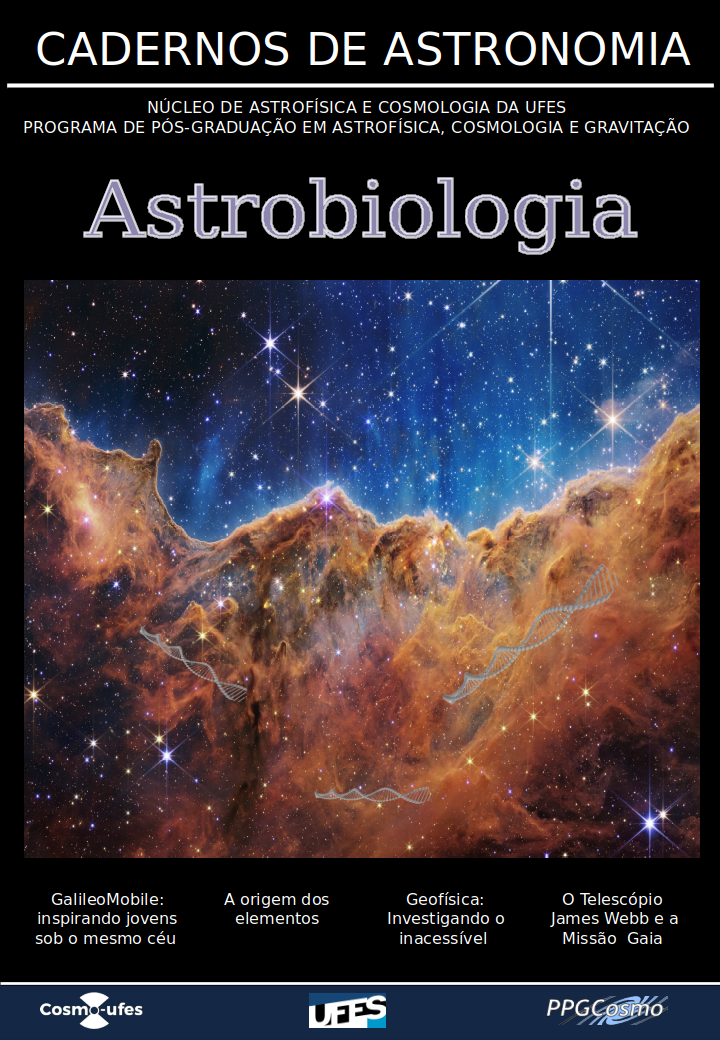Impact of star activity on exoplanet habitability
DOI:
https://doi.org/10.47456/Cad.Astro.v3n2.38943Keywords:
solar activity, stellar activity, spots, stellar flares, exoplanets, planetary habitabilityAbstract
The Sun as well as the stars exhibit magnetic activity in the form of dark spots on their surface, in addition they also produce flares and mass ejections from their atmospheres. The signatures of dark spots on the surface of stars can be modeled so as to characterize their sizes and temperatures. Young and M dwarf stars produce energetic superflares, which can impact orbiting planets, especially those very close to their host star. The flux of ultraviolet radiation from these flares can be very harmful to potential organisms living on the surface of exoplanets orbiting in the habitable zone of active stars. However, an atmosphere with ozone could protect them, or perhaps an ocean. Winds also affect the planetary atmospheres and may be responsible for their erosion.
Downloads
References
A. V. R. Silva, Nossa Estrela: o Sol (Livraria da Física, São Paulo, 2006).
A. D. Wittmann e Z. T. Xu, A catalogue of sunspot observations from 165 BC to AD 1684, Astronomy & Astrophysics Supplement Series 70(1), 83 (1987). Disponível em https://ui.adsabs.harvard.edu/abs/1987A&AS...70...83W, acesso em ago. 2022.
J. A. Eddy, The Maunder Minimum, Science 192(4245), 1189 (1976).
A. Valio et al., Correlations of Sunspot Physical Characteristics during Solar Cycle 23, Solar Physics 295(9), 120 (2020).
H. Schwabe, Die Sonne. Von Herrn Hofrath Schwabe, Astronomische Nachrichten 20(17), 283 (1843).
H. Hudson e J. Ryan, High-Energy Particles In Solar Flares, Annual Reviews of Astronomy and Astrophysics 33, 239 (1995).
S. W. Kahler, Solar flares and coronal mass ejections., Annual Reviews of Astronomy and Astrophysics 30, 113 (1992).
M. Opher et al., Magnetized jets driven by the Sun: The structure of the heliosphere revisited—Updates, Physics of Plasmas 23(5), 056501 (2016).
E. Parker, Extension of the Solar Corona into Interplanetary Space, Journal of Geophysical Research 64(11), 1675 (1959).
E. N. Parker, Hydromagnetic Dynamo Models., The Astrophysical Journal 122, 293 (1955).
S. S. Vogt e G. D. Penrod, Doppler imaging of spotted stars : application to the RS Canum Venaticorum star HR 1099., Publications of the Astronomical Society of the Pacific 95, 565 (1983).
K. G. Strassmeier, Doppler imaging of stellar surface structure. XI. The super starspots on the K0 giant HD 12545: larger than the entire Sun, Astronomy & Astrophysics 347, 225 (1999). Disponível em https://ui.adsabs.harvard.edu/abs/1999A&A...347..225S, acesso em ago. 2022.
A. F. Lanza et al., Modelling the rotational modulation of the Sun as a star, Astronomy & Astrophysics 403, 1135 (2003).
A. F. Lanza et al., Magnetic activity in the photosphere of CoRoT-Exo-2a. Active longitudes and short-term spot cycle in a young Sun-like star, Astronomy and Astrophysics 493(1), 193 (2009). ArXiv:0811.0461.
A. Silva-Válio, Starspot detection from planetary transits observed by CoRoT, in Revista Mexicana de Astronomia y Astrofisica Conference Series (2009), vol. 35, 13– 18. Disponível em https://www.astroscu.unam.mx/RMxAC/vol35.html, acesso em ago. 2022.
A. V. Silva, Method for spot detection on solar-like stars, The Astrophysical Journal Letters 585(2), L147 (2003).
A. Valio et al., Activity and rotation of Kepler-17, The Astrophysical Journal 835(2), 294 (2017).
A. Araújo e A. Valio, Kepler-411 differential rotation from three transiting planets, The Astrophysical Journal Letters 907(1), L5 (2021).
W. J. Borucki et al., Kepler planet-detection mission: introduction and first results, Science 327(5968), 977 (2010).
H. Maehara et al., Superflares on solar-type stars, Nature 485(7399), 478 (2012).
A. Segura et al., The effect of a strong stellar flare on the atmospheric chemistry of an Earth-like planet orbiting an M dwarf, Astrobiology 10(7), 751 (2010).
K. G. Kislyakova et al., XUV-Exposed, Non-Hydrostatic Hydrogen-Rich Upper Atmospheres of Terrestrial Planets. Part II: Hydrogen Coronae and Ion Escape, Astrobiology 13(11), 1030 (2013). ArXiv:1212.4710.
A. Skumanich, Time Scales for Ca II Emission Decay, Rotational Braking, and Lithium Depletion, The Astrophysical Journal 171, 565 (1972).
G. Pace, Chromospheric activity as age indicator. An L-shaped chromospheric-activity versus age diagram, Astronomy and Astrophysics 551, L8 (2013). ArXiv:1301.5651.
D. Lorenzo-Oliveira et al., The Solar Twin Planet Search. The age-chromospheric activity relation, Astronomy and Astrophysics 619, A73 (2018). ArXiv:1806.08014.
V. S. Airapetian et al., Impact of space weather on climate and habitability of terrestrial-type exoplanets, International
Journal of Astrobiology 19(2), 136 (2020). ArXiv:1905.05093.
R. C. Estrela e A. S. Valio, Superflare ultraviolet impact on Kepler-96 system: A glimpse of habitability when the ozone layer first formed on Earth., Astrobiology 18(11), 1414 (2018).
R. Estrela, S. Palit e A. Valio, Surface and Oceanic Habitability of Trappist-1 Planets under the Impact of Flares, Astrobiology 20(12), 1465 (2020). ArXiv:2008.09147.
K. Vida et al., Frequent Flaring in the TRAPPIST-1 System—Unsuited for Life?, The Astrophysical Journal 841(2), 124 (2017). ArXiv:1703.10130.
T. N. Woods et al., Solar irradiance variability during the October 2003 solar storm period, Geophysical Research Letters 31(10), L10802 (2004).
S. L. Hawley e B. R. Pettersen, The Great Flare of 1985 April 12 on AD Leonis, The Astrophysical Journal 378, 725 (1991).
J. T. O’Malley-James e L. Kaltenegger, UV surface habitability of the TRAPPIST-1 system, Monthly Notices of the Royal Astronomical Society 469(1), L26 (2017). ArXiv: 1702.06936.
A. Modi, R. Estrela e A. Valio, Modeling the Atmospheric Evolution of Small Planets Orbiting M-dwarfs due to StellarWind and Photoevaporation (2022), submetido ao Monthly Notices of the Royal Astronomical Society.
Downloads
Published
How to Cite
Issue
Section
License
Copyright (c) 2022 Adriana Valio

This work is licensed under a Creative Commons Attribution 4.0 International License.






